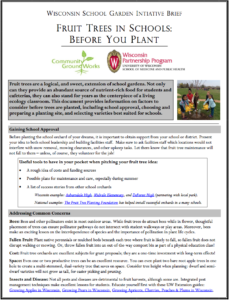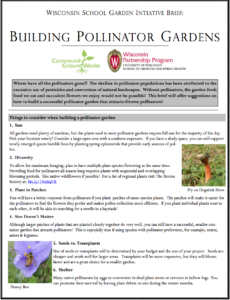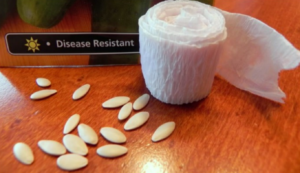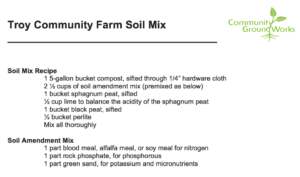 Fruit trees are a logical, and sweet, extension of school gardens. Not only can they provide an abundant source of nutrient-rich food for students and cafeterias, they can also stand for years as the centerpiece of a living ecology classroom. This document provides information on factors to consider before trees are planted, including school approval, choosing and preparing a planting site, and selecting varieties best suited for schools. Download Brief »
Fruit trees are a logical, and sweet, extension of school gardens. Not only can they provide an abundant source of nutrient-rich food for students and cafeterias, they can also stand for years as the centerpiece of a living ecology classroom. This document provides information on factors to consider before trees are planted, including school approval, choosing and preparing a planting site, and selecting varieties best suited for schools. Download Brief »
Building Pollinator Gardens
 Where have all the pollinators gone?! The decline in pollinator populations has been attributed to the excessive use of pesticides and conversion of natural landscapes. Without pollinators, the garden fresh food we eat and succulent flowers we enjoy would not be possible! This brief will offer suggestions on how to build a successful pollinator garden that attracts diverse pollinators! Download Brief »
Where have all the pollinators gone?! The decline in pollinator populations has been attributed to the excessive use of pesticides and conversion of natural landscapes. Without pollinators, the garden fresh food we eat and succulent flowers we enjoy would not be possible! This brief will offer suggestions on how to build a successful pollinator garden that attracts diverse pollinators! Download Brief »
Seed Tape/Seed-Infused Paper
 Get students thinking about gardening in the winter months by making seed tape from old party streamers – perfect for holiday gifts, and for planting in the spring! If you want a more advanced craft, try making your own seed-infused paper! View Resource »
Get students thinking about gardening in the winter months by making seed tape from old party streamers – perfect for holiday gifts, and for planting in the spring! If you want a more advanced craft, try making your own seed-infused paper! View Resource »
Troy Farm Soil Mix
 This recipe works well, and is much cheaper than buying bagged potting soil if you are planning to start more than a few trays of seeds. You can also turn this into a great lesson about sustainability by discussing the benefits and drawbacks of different ingredients – i.e. peat makes wonderful soil mix, but what is the environmental impact? Is there a better alternative? For a great lesson about plant nutrients, minerals, and/or compost, try making your own seed-starting soil mix. View Resource »
This recipe works well, and is much cheaper than buying bagged potting soil if you are planning to start more than a few trays of seeds. You can also turn this into a great lesson about sustainability by discussing the benefits and drawbacks of different ingredients – i.e. peat makes wonderful soil mix, but what is the environmental impact? Is there a better alternative? For a great lesson about plant nutrients, minerals, and/or compost, try making your own seed-starting soil mix. View Resource »
